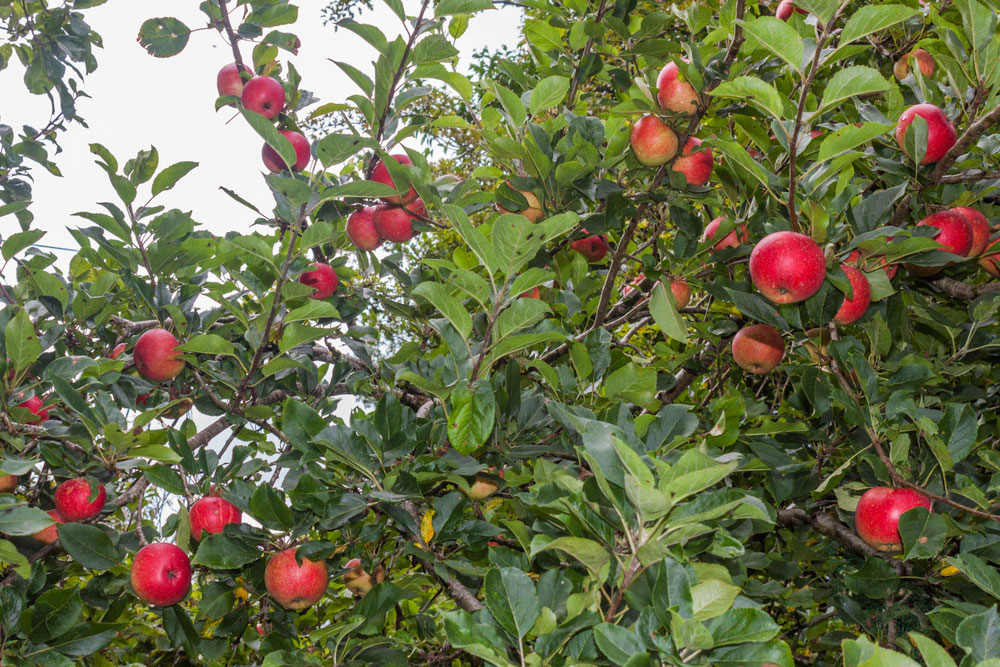Irish apples boast a captivating journey from delicate blossoms to the crisp bites enjoyed in kitchens across the country. This exploration unveils the captivating life cycle of these fruits, from their blossoming beginnings to the harvest, showcasing the stages that shape the beloved Irish apple.
Springtime Blossoms: Awakening Orchards
As the early months gently coax Ireland out of winter’s embrace, the orchards undergo a breathtaking transformation, an annual spectacle etched in nature’s calendar. Across verdant landscapes and rolling hills, the apple trees awaken from their slumber, adorned in a resplendent garment of delicate blossoms.
The orchards, once dormant and unassuming, burst into a celebration of colors—shades of white, tinged with blushes of pink and hues of delicate pastels. The air itself seems to shimmer with the sheer abundance of blossoms, a mesmerizing panorama that blankets the countryside.
Amidst this visual symphony, a silent but crucial invitation is extended to nature’s pollinators. The apple blossoms, beyond their aesthetic allure, beckon to bees and other insects in a dance as old as time itself. Their fragrant aroma and delicate petals serve as beacons, drawing in these vital pollinators to partake in the age-old ritual of fruit production.
The role of bees, nature’s consummate workers, takes center stage in this orchestration. Buzzing with purpose, they flit from bloom to bloom, collecting nectar and unwittingly transferring pollen—a seemingly mundane task that forms the cornerstone of the apple’s lifecycle. Their diligent efforts, as they traverse the orchard in search of sustenance, unwittingly ensure the intricate pollination process that marks the genesis of the apple’s growth.
In this delicate dance, the symbiosis between the blossoms and the bees unfolds. Each blossom holds the promise of becoming an apple, and each bee contributes to this promise, carrying pollen grains from one flower to another. The intricate interplay between nature’s offerings and the tireless work of these pollinators sets the stage for the miraculous transformation that follows—the formation of the apples themselves.
The delicate springtime blossoms, beyond their sheer beauty, serve as harbingers of the apple’s lifecycle. They herald not just the arrival of spring, but the inception of a journey that intertwines the natural world’s elegance, the tireless dedication of pollinators, and the beginning of the orchard’s bounty. In this symphony of nature, the simple beauty of blossoms paves the way for the abundance that graces Ireland’s orchards in the seasons to come.
Fruit Formation: The Growth Phase
Following successful pollination, the orchard’s landscape undergoes a subtle yet significant transformation. The blossoms, once a testament to nature’s artistry, begin a remarkable metamorphosis into nascent apples. This pivotal phase, fruit formation, marks the inception of the apple’s growth cycle, encapsulating a journey intricately woven with care, environmental factors, and nature’s grace.
The transformation begins imperceptibly, as tiny, green orbs emerge at the site of the once-pollinated blossoms. These incipient fruits, barely visible amidst the foliage, represent the initial stage of fruit formation. The orchard’s caretakers, attuned to the nuances of the apple’s growth, employ a delicate balance of attentive care and environmental stewardship during this critical period.
Proper care becomes paramount in nurturing these fledgling apples. The orchard’s soil, once a nurturing bed for blossoms, now hosts the burgeoning fruits. Appropriate irrigation, nutrient-rich soil, and vigilant pest management are essential elements in fostering the fruits’ development. Pruning and thinning may be employed to encourage optimal growth and prevent overcrowding, allowing each apple the space and resources it requires to thrive.
Climate and weather intricately influence the fruit’s growth trajectory. The orchard’s microclimate, a unique interplay of temperature, sunlight, and precipitation, influences the apples’ development. From the warmth of spring to the heat of summer and the crispness of autumn, each season imparts its distinct impact on the apples. Adequate sunlight is essential, fostering photosynthesis and the development of sugars crucial to the fruits’ flavor profile.
However, the capriciousness of weather remains an ever-present factor. Frost, unseasonable rains, or extended heatwaves can pose challenges to the growing apples. Orchards equipped with protective measures, such as netting or irrigation systems, shield the fruits from adverse weather, safeguarding their growth and quality.
Throughout this growth phase, a symphony of natural elements and human care harmonizes to nurture the apples. The orchard becomes a sanctuary where the delicate balance between nature’s rhythms and human intervention shapes the fruits’ destiny. And within the quiet embrace of the orchard, the apples, once tiny and unassuming, steadily progress towards their full, ripened state—a testament to the seamless synergy between cultivation, climate, and the wonders of nature.
Maturation and Orchard Care: Nurturing the Crop
As the apple blossoms complete their ethereal display and transition into nascent fruits, the orchard’s caretakers step into a pivotal phase of nurturing—the maturation and care of the burgeoning crop. With meticulous attention and a deep-rooted understanding of the orchard’s needs, this stage marks a critical juncture in ensuring a bountiful and healthy harvest.
Careful tending of the trees becomes the cornerstone of orchard management during this phase. Each tree is tended to with an expert’s eye, as if they were individual works of art. The caretakers, seasoned custodians of the orchard’s bounty, embark on a series of tasks aimed at fostering optimal growth. From judicious irrigation to maintaining nutrient-rich soil, every aspect is methodically addressed to meet the trees’ requirements.
Pruning techniques take center stage in this stage of orchard care. Pruning, a meticulous art form passed down through generations, shapes the trees’ growth and optimizes fruit production. With skilled hands and precision, superfluous branches are trimmed, ensuring adequate sunlight penetration and air circulation—vital elements for healthy fruit development.
Pest management forms an integral part of the orchard’s caretaking regime. Orchards, like delicate ecosystems, are susceptible to various pests and diseases that can jeopardize the apple crop. Organic and sustainable practices take precedence, employing natural deterrents or environmentally friendly methods to mitigate potential threats, safeguarding both the fruits and the orchard’s ecosystem.
Sustainability takes precedence in modern orchard care, aligning agricultural practices with environmental stewardship. Careful resource management, such as water conservation and soil preservation, ensures a balanced approach that nurtures the trees without depleting natural resources. Integration of sustainable practices not only safeguards the present harvest but also ensures the orchard’s longevity for generations to come.
In the intricate choreography of orchard care during maturation, a harmonious blend of expertise, traditional wisdom, and innovative practices converges. The orchard becomes a sanctuary where the custodians, dedicated to the craft, work tirelessly to cultivate a thriving ecosystem. And within this tapestry of care and sustainability, the burgeoning apples progress steadily towards maturity—a testament to the unwavering commitment to nurturing nature’s bounty.

The Harvest Season: Bringing Fruits to Market
The arrival of the harvest season heralds the grand finale of the apple’s captivating lifecycle—a period eagerly awaited in the orchards across Ireland. It marks the culmination of months of meticulous care, natural rhythms, and the orchestration of nature’s processes. As the apples reach their peak ripeness, the orchestration of their journey from the branches to marketplaces begins, inviting a flurry of activity and celebration.
Timing is paramount during the harvest, as the optimal moment to pluck the apples from their branches determines their quality and flavor. Orchards hum with activity as caretakers, equipped with seasoned expertise and a discerning eye, assess the fruits’ readiness. Each variety holds its unique indicator—the blush of color, a subtle yield to gentle pressure—signaling its readiness for harvest. It’s a delicate balance, ensuring that the apples are perfectly ripe for the journey from tree to market.
The orchards transform into bustling hubs of activity during this season. The air is infused with a palpable energy as workers meticulously handpick the fruits, navigating the verdant rows of trees laden with nature’s bounty. Crates brimming with crisp apples steadily fill, a testament to the tireless efforts of the individuals carefully plucking and sorting the fruits—a labor of love and dedication that ensures the apples’ pristine quality.
Local communities play an integral role in this seasonal celebration. Harvest time isn’t merely an event confined to the orchards; it’s a communal celebration that transcends the boundaries of the orchard fences. Families, friends, and neighbors join hands, converging on the orchards to partake in this time-honored tradition. It’s a moment for camaraderie and shared efforts, a reminder of the intrinsic connection between the land, its fruits, and the people who cultivate them.
Amidst this bustling activity, a sense of celebration permeates the orchards. Laughter intermingles with the rustle of leaves as the crates brim with apples, signifying not just the culmination of the apple’s life cycle but also the commencement of a new journey—the journey from orchard to market, from the hands of the caretakers to the tables of communities far and wide.
The harvest season is a tapestry woven with the threads of anticipation, hard work, and the essence of community. It’s a celebration of nature’s bounty and the dedication of those who nurture it—an embodiment of the cyclical harmony between man and nature, marked by the apples’ journey from branches to markets.
Post-Harvest Handling and Storage
After the culmination of the vibrant harvest season, the apples embark on a new chapter, transitioning from the branches to meticulous post-harvest handling and storage—an essential phase that preserves their quality and ensures their journey from orchard to market is one of pristine freshness.
Proper handling is paramount in maintaining the apples’ quality post-harvest. Carefully trained hands sort through the crates, meticulously examining each apple for imperfections or signs of damage. The fruits deemed perfect for consumption are separated from those destined for other uses, ensuring that only the finest apples make their way to market.
Sorting, an intricate process often augmented by modern technologies, aids in classifying the apples based on size, color, and quality. State-of-the-art machinery and sorting systems, equipped with high-resolution cameras and sensors, streamline the process, allowing for efficient and precise separation of apples according to predefined criteria.
Storage techniques play a pivotal role in preserving the apples’ freshness and taste. Orchards often utilize controlled atmosphere storage facilities, where temperature, humidity, and gas levels are meticulously regulated. These environments mimic the ideal conditions necessary to extend the apples’ shelf life while retaining their crispness and flavor.
Innovative preservation methods complement traditional techniques, ensuring the apples’ longevity without compromising their quality. Cool storage rooms, a practice rooted in tradition, offer a haven where the apples rest in a climate-controlled environment, shielded from external elements that might compromise their freshness.
Additionally, advancements in preservation technologies, such as low-oxygen storage and ethylene management systems, further refine the art of apple preservation. These cutting-edge methods aid in maintaining the fruits’ optimal condition, allowing them to withstand extended storage periods without compromising taste or texture.
Beyond technological advancements, time-honored preservation practices continue to hold significance. From wax coatings that protect against dehydration to wrapping individual apples in paper—a method reminiscent of bygone eras—these traditional techniques complement modern innovations, collectively contributing to the apples’ longevity and quality.
In this post-harvest phase, a symphony of meticulous handling, sorting, and preservation techniques converges. It’s a harmonious blend of tradition and innovation, ensuring that the apples, having completed their journey from the orchard, remain pristine, fresh, and ready to grace tables with their natural sweetness and crispness.
Farm to Table: Apple in Culinary Delights
As the apples make their journey from orchard to table, they step into the vibrant tapestry of culinary delights—a journey that transcends the boundaries of the orchard and finds its culmination in the kitchens, cafes, and markets across Ireland. These versatile fruits, nurtured through seasons and harvested with care, become the cornerstone of an array of delectable culinary creations, reflecting the rich heritage and culinary prowess of Irish cuisine.
In kitchens, the apples become protagonists in a myriad of dishes, from time-honored traditional recipes passed down through generations to modern, innovative culinary delights. Their versatility shines as they effortlessly transition from sweet to savory, catering to a diverse range of culinary preferences.
The apples take center stage in classic desserts, such as the iconic apple pie or the comforting apple crumble, their tender sweetness harmonizing with spices to create heartwarming indulgences. Whether baked into pies, folded into flaky pastries, or stewed to perfection, the apples infuse these desserts with a tantalizing aroma and a burst of natural sweetness.
Beyond desserts, the apples lend their unique flavor profiles to savory dishes, offering a delightful contrast in salads, savory tarts, or paired with hearty meats in comforting stews. Their crisp texture and balanced sweetness add depth to salads, while their ability to hold shape during cooking makes them ideal companions in savory dishes, offering a subtle yet distinctive flavor.
In cafes and markets, the apples find their way into artisanal creations and freshly pressed juices, celebrating their natural essence. Their journey doesn’t conclude in the confines of kitchens; rather, they emerge as stars in farmer’s markets, where their fresh, crisp presence beckons passersby, inviting them to partake in their succulence.
The significance of apples in Irish cuisine transcends mere culinary uses; it embodies a cultural legacy. The fruits, sourced locally and steeped in tradition, symbolize the connection between the land and its people. Their consumption embodies a celebration of nature’s bounty, reflecting the cyclical harmony between cultivation, seasons, and the joys of indulging in wholesome, locally grown produce.
In essence, the journey of the apple—from orchard to table—culminates in a symphony of flavors and culinary experiences that celebrate the essence of Irish cuisine. It’s a testament to the apple’s versatility, enriching the culinary landscape and leaving an indelible mark on the palates and traditions of Ireland.
Try some of our apple inspired recipes:
IRISH APPLE CAKE
IRISH APPLE AND CABBAGE COLESLAW
IRISH APPLE TART
IRISH PARSNIP AND APPLE SOUP
APPLE MASH
APPLE BARLEY PUDDING







